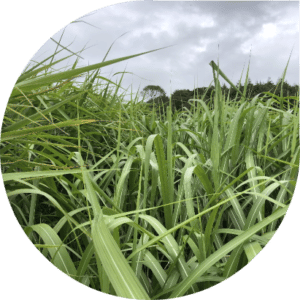Biomass Crops
Biomass is the organic material from living organisms. In the context of Biomass Connect, the term refers to non-food crops where the whole aboveground plant biomass is harvested and used for a range of purposes including for heat and power (electricity), fuel for transport, platform chemicals, and a range of construction, packaging, and cosmetic applications.
Importantly, the carbon captured from the atmosphere by these biomass crops during photosynthesis is contemporary carbon, rather than the ancient carbon stored in fossil fuels, the use of which results in a net increase in CO2.
Like solar, wind, and tidal energies, the use of biomass doesn’t deplete finite resources (compare coal, gas, and oil). However, biomass has important and unique characteristics that make it essential in our transition away from fossil fuels. It is the only renewable energy source that can be converted into liquid biofuels and a host of bio-based chemicals that can act as building blocks to replace those currently derived from fossil fuels.

The crops used within the Biomass Connect project all have high growth rates and require far less fertiliser/pesticide/herbicide use (often none beyond establishment) than most arable crops. And apart from hemp, the crops within Biomass Connect are all perennials. This means they do not require annual cultivation, a process that usually involves tillage or ploughing and results in increased emissions. They also recycle their own nutrients. This is important for sustainability (requiring zero to low fertiliser), and also means that those nutrients will not be present if the biomass is combusted for heat or electricity generation, which would otherwise release noxious gases such as nitrous and potassium oxide, or corrosive compounds like potassium chloride.
Dedicated biomass crops are an essential part of our journey to net zero+ (the ‘+’ denoting added benefits that we also need alongside net zero, such as soil health, biodiversity gain, and ecosystem services). The Biomass Connect platform is designed to demonstrate and evaluate these crops in different UK locations and to provide a better understanding of geographic variation in the production of biomass crops. The platform is also designed to provide guidance on best practice and innovations in biomass cultivation, and to share knowledge gained among and between growers as well as government advisers, trade bodies, businesses, and biomass end users.
The information below provides independent information on biomass feedstock performance, agronomy, economics, and environmental benefits but it is not specific advice or an endorsement for a particular practice, crop, supplier, or method. It is important that you conduct your own thorough research and seek professional advice as necessary before any planting, including regarding any specific regulation or restrictions on crops or practices in your area.
We seek to share knowledge and experiences that can make a significant contribution to agricultural, environmental and bioenergy policy development, practical on-farm development, and overall growth in the UK’s biomass sector.
Short Rotation Forestry (SRF) Crops
*Short rotation coppice (SRC, 2-3 harvest cycle) Short rotation forestry (SRF, *-* harvest cycle)